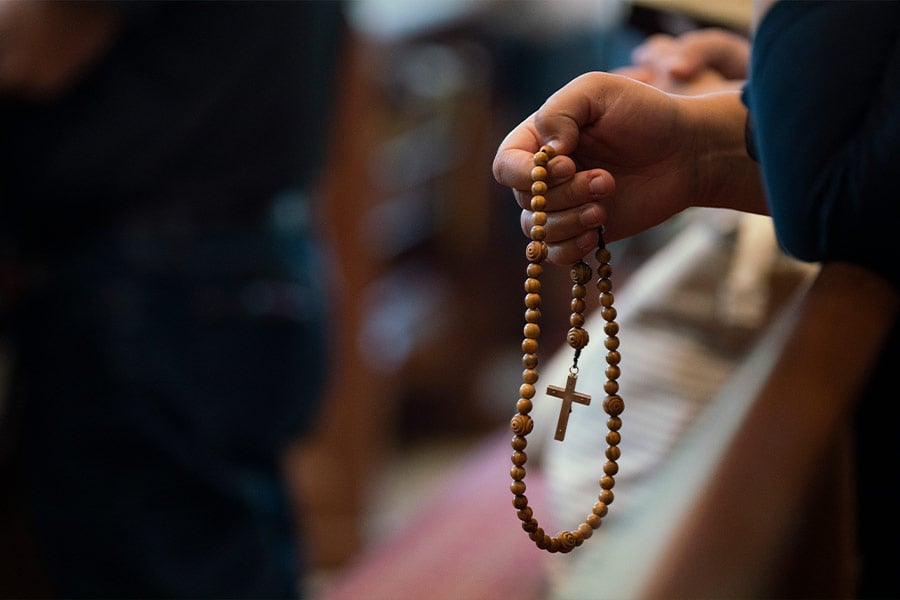The Rosary and the Power of Repetition

A worshipper holds a rosary during a Mass at St. John Paul II Parish in Denton. (NTC/Juan Guajardo)
Repetition is a funny thing. We seem to be as easily comforted by it as made bored and prone to distraction by it. We have all had the experience of yearning for change, and for all the excitement and potential growth that comes with it. But when everything around us is change, and we feel unable to jump off the merry-go-round, our old routines and habits begin to look more and more attractive.
As Catholics, we are no strangers to repetition. The holy Mass, offering to us the Eucharist, the “source and summit” of our faith, is repetitious by its very nature. Every day, in every corner of the globe, the same prayers of consecration are said over a host by a priest. One could argue that repetition is a defining aspect of Catholicism; the same message given to the Apostles by Christ Himself echoing down through the ages.
One prayer (or rather group of prayers), that stands as testament to this is the Rosary, to which the Church has dedicated the month of October.
To modern Catholics, it may be difficult to imagine the Church without the Rosary. In the centuries since its inception, it has become such a centerpiece of Catholic devotion that removing it would be the spiritual equivalent of lopping off the dome of Saint Peter’s Basilica. Strange though it may seem however, the Rosary has not been around forever. Equally puzzling is the fact that there appears to be no specific place or time to which historians can point and say, “here is where the Rosary began.” Rather, much like a rose bush itself, it was something that grew organically from the fertile soil of the faithful, from their love for Jesus and His Blessed Mother.
According to a Vatican News article entitled “The Popes and the Rosary”, although it had existed in one form or another for many years, it wasn’t until the 15th century that Pope Sixtus IV granted the Rosary official Church approval. The Dominicans appear to have played an active role in the promotion of the Rosary during this period as well, encouraging devotion to Mary through its use. The Rosary was also much more lengthy at that time, including 150 Hail Mary’s. By the 16th century, the Rosary as we know it today, with five decades centered around a set of Mysteries, began to emerge1.
On October 7th, 1571, the Battle of Lepanto was fought; a contest between the naval forces of the Holy League and that of the Ottoman Empire. This was a battle whose outcome could have changed the course of history. Aware that the fate of Christianity in Europe hung in the balance, Pope Saint Pius V had urged prayer of the Rosary for the fate of the forces of the Holy League prior to this decisive engagement. On the waters of the Mediterranean that October day, the Battle of Lepanto was won by the outnumbered Christian ships2.
I believe my personal history with the Rosary mirrors that of a good number of Catholics. As someone who was raised in the faith, I have been aware of the Rosary for as far back as I can remember. Going to Catholic school, I recall prayer services in which our entire class recited the Rosary. Our religion teachers educated us regarding each of the Mysteries, explaining their significance. However, as with anything that has maintained a constant presence in your life, it can become frightfully easy to take that thing for granted. I have found myself utilizing the repetition of the Rosary many times merely as a way to fall asleep.
I don’t think it was until high school and I had received the Sacrament of Confirmation, that I began to seriously pray the Rosary, to truly immerse myself in the stories it tells and meditate on their meanings. And not just in an abstract way; I appreciated anew that these windows into key moments in the lives of Jesus and Mary had much to teach me about how I should live mine. Perhaps this new understanding is just something that comes with age.
The Rosary is far more than mere repetition; it is a direct link from us to God and His Mother. The Rosary is powerful.
1. Edward Sri. The Origins of the Rosary. Franciscan Media.
2. Michael Novak. 2014. How the 1571 Battle of Lepanto Saved Europe. Catholic Education Resource Center.
